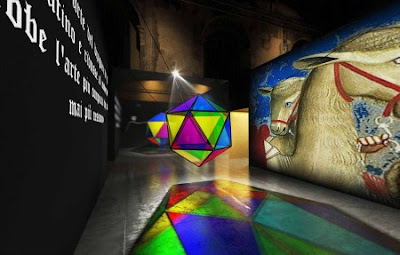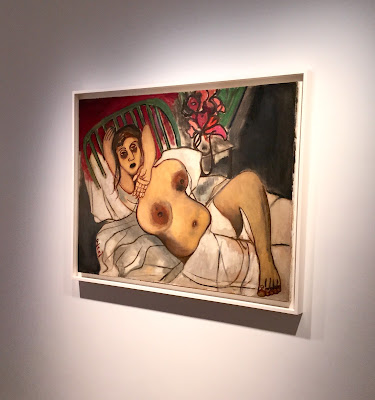Joachim was a wealthy, pious man, and Anne was his beloved, but childless wife -- a situation that gave the couple much grief. Both were descendants of the house of David. Joachim was generous with his wealth, giving to the poor, and making offerings to the temple. Then one day the high priest said he would not accept Joachim's offerings because he was childless, and, therefore, God must be displeased with him.
Joachim went off to the desert to fast and pray for 40 days and nights, while Anne sobbed and prayed at home in their garden. An angel appeared separately to both of them, and promised the devout couple that they would have a child, even in their old age -- and not just any child, but the mother of God. They were instructed to meet each other at the Golden Gate in Jerusalem.
 |
| The Meeting at the Golden Gate by Giotto |
And the woman in black? There is much disagreement about who she is, but the theory I like the best is that she is Mary, the mother of Jesus, after Christ was crucified, witnessing the moment of her own conception. Very quantum theory.
Back in 2007, Tom Lubbock wrote an excellent piece for The Independent called, Bondone, di Giotto: The Meeting at the Golden Gate (1305) where he examines famous kisses in art, this kiss in particular.
I did not know any of that before I saw MAGISTER GIOTTO at the Scuola Grande della Misercordia.
 |
| Magister Giotto |
Giotto is considered the first great artist to contribute to the Renaissance, and after you visit the exhibition, you will understand why.
 |
| Giotto press conference - Scuola Grande della Misericordia - Photo: Cat Bauer |
Cose Belle d’Italia is a group that aggregates Italian companies representing Made in Italy excellence, acquiring, preserving and valorising them within an integrated system based on the perennial values of Italian beauty, culture and ‘the good life’.
The group operates across all sectors, creating value and promoting the propagation of excellence among its subsidiaries.
Fully owned by Europa Investimenti S.p.A., Cose Belle d’Italia was founded in 2013 following the definition of its ‘Manifesto’, which sets the key points on which the vision and mission of the company are based. The first acquisitions began in the spring of 2014.
 |
| Magister Giotto |
The main exhibition consists of seven spaces on the first floor of the immense Scuola Grande della Misericordia, each with a different theme. Visitors are organized into groups of about 15-20 people that depart every 15 minutes. The visitors put on headsets, and the narrative starts, sort of like a documentary film that you wander through, with background music by jazz musician, Paolo Fresu.
The Italian narrator is Luca Zingaretti, one of the most well-known actors in Italy, who plays Salvo Montalbano in the Commissario Montalbano TV mystery series. (The TV show is based on the addictive novels by Andrea Camilleri, which I highly recommend reading. They are translated into English by the talented Stephen Sartarelli, with a creative solution when the characters slip from speaking Italian into speaking Sicilian.)
The themes of the seven spaces are:
1. The Birth of the Myth
2. The Story of Saint Francis
3. The Places of Giotto
4. Giotto and the Painted Cross
5. Giotto and Florence
6. The Scrovegni Chapel
7. Giotto and Halley's Comet
i |
| Envy by Giotto |
Envy (from Latin invidia) is an emotion which "occurs when a person lacks another's superior quality, achievement, or possession and either desires it or wishes that the other lacked it".I was speaking about envy just before I went to see the exhibition, and then there it was -- wicked tongue, big ears, bag of money and all -- up there on the wall, so close that I could walk over and almost touch it.
 |
| Magister Giotto - Photo: Cat Bauer |
Giotto completely transformed the art of painting. The Italian painter Cennino Cennini nailed it when he said, "Giotto translated the art of painting from Greek to Latin."
 |
| Adoration of the Magi by Giotto |
MAGISTER GIOTTO is at the Scuola Grande della Misericordia through November 5, 2017, and is a MUST SEE. Tickets are €18, but there are many discounts; for instance, the exhibition is FREE for residents of Venice every Tuesday. Go to MAGISTER GIOTTO for more information and to visit the very slick website.
Ciao from Venezia,
Cat Bauer
Venetian Cat - The Venice Blog



























